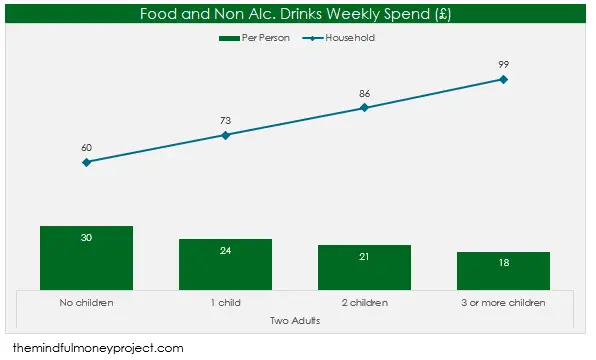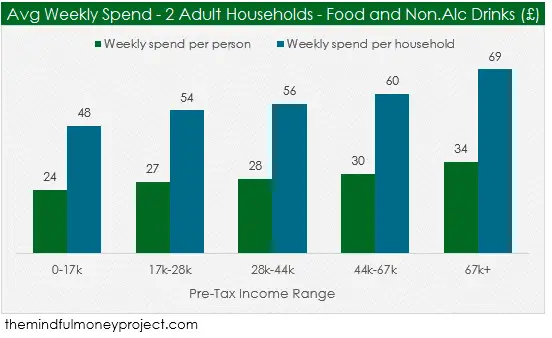With the current cost of living crisis in the United Kingdom, it makes sense to stay on top of your expenses. As food tends to take up a large portion of your weekly expenditure, it is worth looking at if there are any ways to reduce it. First though, you’ll need to understand what is a useful benchmark for people in a similar situation. This is where we have lots of people asking us: “what is the average weekly food shop for 2 adults in the UK?” which has prompted us to put together this analysis.
Average Weekly Food Shop for 2 UK
The average weekly food shop for 2 adult households in the UK is £60 (£261 per month), working out at £30 per person (£131 per person per month). If there are children in the household then this increases too as you can see in the table below.
This excludes any spend on alcoholic drinks and also excludes any spend on eating out at restaurants.

| Household Composition | Weekly | Monthly | Yearly |
| Two Adults | £60 | £261 | £3,136 |
| Two Adults, 1 child | £73 | £316 | £3,796 |
| Two Adults, 2 children | £86 | £372 | £4,467 |
| Two Adults, 3 or more children | £99 | £430 | £5,158 |
However, it is important to note that this is a nationwide average. This covers lots of variations based on factors such as income…
The Average Weekly Food Shop Varies Based On Income Level
As you would expect, your level of income has a big impact on the average weekly groceries budget across households.
For the income bracket £0-£17k (pre-tax), the average weekly groceries spend for 2 adults is £48 (£208 per month). This increases to £56 per week (£243 per month) in the income bracket £28k-£44k. At the highest bracket of £66k+, the average weekly food cost is £69 per week (£299 per month).

If you would like to read more about weekly food budgets and costs, check out our deep-dive on the average cost of food for an average UK household (including retired households), as well as a deep-dive into food spend for adults living alone.
Source of data
The Office for National Statistics (ONS) runs a survey of over 5000 households who track their expenditure for two week periods at a time, in order to help understand consumer behaviour and spending over time. Luckily for us, the ONS also publicly releases this data, allowing us to run useful analyses like this. They even cut and dice the data in some fascinating ways, including region, income level and household composition.
These surveys take place over the full year and so also take into account any seasonality such as the higher food spending at Christmas.
Understand Your Own Food Costs
If you’re on this article, you’re likely looking for a benchmark to check your spending against. But have you got an accurate picture of your own spending already?
There are lots of easy ways to track your grocery spend without involving spreadsheets!
Some brilliant new personal finance apps can connect to your bank account and automatically track your spending across an array of spend categories. Groceries being one.
Our favourites are Plum* and Snoop*.
You connect your bank account using Open Banking, and these apps will categorise your transactions, help you set a budget, track spending and Plum even helps to save money for you if you activate the auto-saving feature.
Plum* also has a feature (called Diagnostic Reports), which gives you a customised benchmark based on your age, salary and location. This is based on live spending data from its database of transactions and user base. Even though the analysis in this article is using robust analyses from the ONS, the benchmarking on Plum will use up to date information which will adjust more quickly with things like inflationary cost increases (as all users will be seeing the same increases).
I love this feature (and it’s a real standout – I haven’t found another finance app offering something similar at the time of writing). So if you’re looking for a budgeting app that can track your spending, and provides useful features like benchmarking, be sure to try out Plum.
How Much Should A Couple Spend On Groceries?
The kind of spend which is right for you as a couple will depend on factors such as where you live, what your income is and whether or not you have kids.
However, using a benchmark such as the information in this article or through Plum’s Diagnostic Reports feature, you’ll be able to get a good idea of what an average couple spends on groceries on a weekly or monthly basis. With this information, you can compare against your current spending, and see how you fare.
When using these benchmarks, however, be sure to take your own intentional budget decisions into account. For example, if you never tend to go out to eat at restaurants and pubs, and therefore do all of your cooking at home then your weekly food shop will be higher than people who eat out at restaurants/pubs all the time. If this fits within your budget and you’re happy with it, then there is no harm in this! A budget doesn’t need to be restrictive after all, it is just simply a way that you allocate your money in line with your goals and values.
How to Reduce Your Spending on Food as a Couple
When you’re teamed up with another person, you have so many more opportunities to reduce your food costs compared to living alone. Here are a few ways to reduce your spending on your weekly food shop as a couple:
Plan ahead with a meal plan
If you agree on a set of recipes (or dishes) for the week ahead before you go grocery shopping, you can get your grocery list lined up before you set food in the shop. This means when you go to the shop, you don’t buy unnecessary items you do not need as you are shopping from your shopping list. Not only does it stop you from buying unnecessary items when you’re there, but planning ahead can also help to reduce food wastage as you’ll only buy the food required for your planned recipes.
Depending on how deep you want to go with it, you can also optimise your shopping to buy items that will be used across multiple recipes.
This also means that you can ensure you have enough food in ahead of time so when you come back from work in the evening tired you won’t end up getting a takeaway due to not having anything ready to go.
You also don’t need to put a lot of work into building a meal plan, this meal planner builds a custom meal plan based on your budget and caloric needs.
Buy in bulk
As there are two people to feed, it makes much more sense to buy in bulk when you can. Rice, pasta, spices, tinned food. Lots of food items tend to be cheaper per unit when you buy in larger quantities.
For items that are not perishable, you can benefit from savings on many foods by buying larger packets and storing them correctly until they’re needed.
Introduce a meat-free day
As well as being good for the environment, introducing at least one meat-free day per week into your meal plan will also be good for your wallet.
Vegetarian dishes tend to be much cheaper than good quality meat-based ones (a vegetable is much cheaper than a chunk of meat after all!
With a plethora of amazing vegetarian recipes out there, you can’t go wrong with experimenting a bit. We recommend Meera Sodha’s East recipe book, for amazing restaurant quality food without the faff (you may need some quirky ingredients to begin with though to be fair).
Are you not into cooking? Try some of these tips to save money on food costs without cooking.
Conclusion: What is the Average Weekly Food Shop for 2 Adults in the UK
With increases in living costs across the board seeing household bills rise indiscriminately, it is important to understand your groceries spend, as the weekly shop typically makes up a large part of a household’s expenses.
Using data from the ONS survey of over 5000 UK households, the average weekly food shop for two adults in the UK is £60 per week (£261 per month).
However, this varies based on income, with higher earners spending more on their weekly food shop than lower earners.
Tracking your food spend is a great way to keep awareness of your spend against your budget. To keep your benchmark up to date, we recommend the Plum* diagnostics report feature which provides you an up to date benchmark to similar people’s spend. This matches you to a group based on your age, location and income. It also uses the data from Plum’s users and so will be more up to date than the ONS surveys which typically have a time lag.
This post may contain affiliate links (any links we earn commission on if you go on to make a purchase are marked with an * asterisk). These do not influence our editorial content and we remain independent.
What Is A Good Amount Of Savings UK?
Generally in life, more tends to be better. But is that true for savings? Whilst…
“Why Should I Track My Expenses?” – We’ve got 7 reasons why!
Tracking your expenses isn’t all about firing up a spreadsheet and restricting your spending. Having…
How To Cancel Graze Subscription UK
Bored of your Graze boxes or want to try a competitor’s version? We get you….
How To Cancel Hellofresh Subscription UK
Bored of the meal kits or want to try a competitor? We get you. We’ve…
How To Cancel Les Mills On Demand UK
Bored of your subscription or wanting to move to another provider? We get you. We’ve…
How To Cancel Laithwaites Wine Plan UK
Bored of the service or wanting to move to a different wine subscription club? We…








